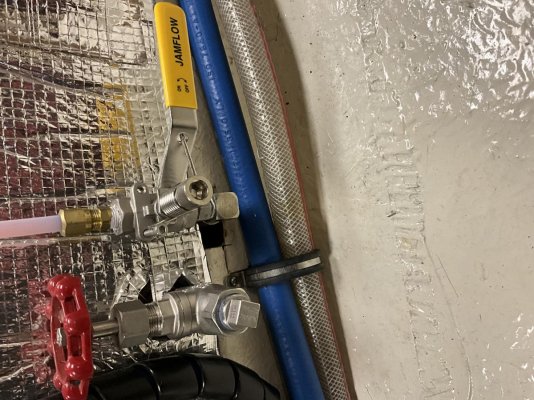MVCalypso
Veteran Member
- Joined
- Jun 13, 2010
- Messages
- 48
- Vessel Name
- Calypso
- Vessel Make
- Island Gypsy 36 Europa 1984
Hi TF denizens,
I'm experiencing a very small diesel weep from a pipe fitting assembly (as in maybe a drop a week) & I'm looking for advice on how to stop it.
Here is the pipe fitting sequence (all are NPT):
I think the weeping is between the AL female and SS close nipple. It's hard to tell, as after a week the bottom of the assembly will be damp to the touch making it hard to localize the source joint.
Side bar: I'm told that SS is used as "close to Al" to avoid (minimize) galvanic action at the tank fitting. Frankly, I don't know why that matters in this case as the joint is not in an electrolyte (fluid is diesel). But I understand it's the "standard practice" and the above is the part sequence I'm dealing with. As there are no Al body ball valves, I think there has to be an Al to SS transition somewhere.
Goal: Understand why this is happening & stop it.
Theory 1: I think NPT threads seal (at least partially) as the result of deformation of the thread crests. I perceive the SS threads as much harder than the mating Al threads. I'm wondering if the SS male thread is simply re-threading the Al female fitting instead of deforming and making a seal.
If this is happening, I'm loath to tighten the close nipple into the Al fitting, as it won't make the joint tighter, and the valve handle could end up in a position (as the valve rotates with the nipple) where is would be hard or impossible to access the handle, or the handle could not rotate a full 90 degrees for on/off.
If this is a valid concern? If so, what I could I do differently...?
Theory 2: The rector seal stays soft forever. I'm not a pipe fitter, but I'm having trouble believing in a "soft sealant" as being very good at sealing. I observe it hasn't "sealed" the joint so far. Diesel is getting past the rector seal goop.
Is there a better goop to use for this?
Any words of wisdom appreciated!
I'm experiencing a very small diesel weep from a pipe fitting assembly (as in maybe a drop a week) & I'm looking for advice on how to stop it.
Here is the pipe fitting sequence (all are NPT):
Al 1" female port welded into an Al tank,
1" SS close nipple inserted into the tank fitting,
SS shut off ball valve,
SS adapter to fuel hose.
The joints were assembled with Rector Seal #5. 1" SS close nipple inserted into the tank fitting,
SS shut off ball valve,
SS adapter to fuel hose.
I think the weeping is between the AL female and SS close nipple. It's hard to tell, as after a week the bottom of the assembly will be damp to the touch making it hard to localize the source joint.
Side bar: I'm told that SS is used as "close to Al" to avoid (minimize) galvanic action at the tank fitting. Frankly, I don't know why that matters in this case as the joint is not in an electrolyte (fluid is diesel). But I understand it's the "standard practice" and the above is the part sequence I'm dealing with. As there are no Al body ball valves, I think there has to be an Al to SS transition somewhere.
Goal: Understand why this is happening & stop it.
Theory 1: I think NPT threads seal (at least partially) as the result of deformation of the thread crests. I perceive the SS threads as much harder than the mating Al threads. I'm wondering if the SS male thread is simply re-threading the Al female fitting instead of deforming and making a seal.
If this is happening, I'm loath to tighten the close nipple into the Al fitting, as it won't make the joint tighter, and the valve handle could end up in a position (as the valve rotates with the nipple) where is would be hard or impossible to access the handle, or the handle could not rotate a full 90 degrees for on/off.
If this is a valid concern? If so, what I could I do differently...?
Theory 2: The rector seal stays soft forever. I'm not a pipe fitter, but I'm having trouble believing in a "soft sealant" as being very good at sealing. I observe it hasn't "sealed" the joint so far. Diesel is getting past the rector seal goop.
Is there a better goop to use for this?
Any words of wisdom appreciated!
Last edited:


